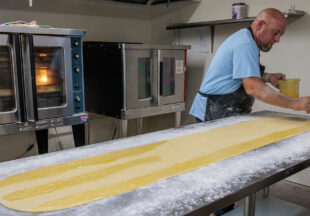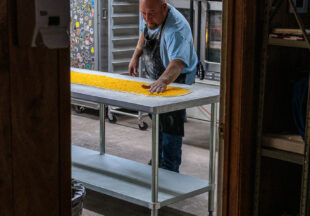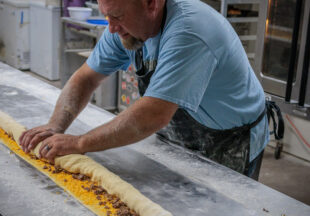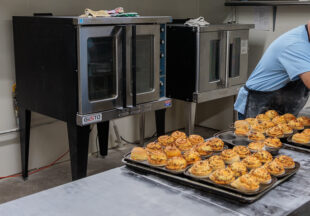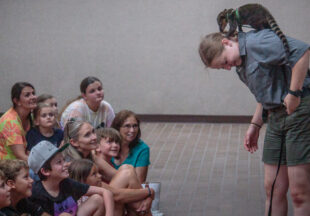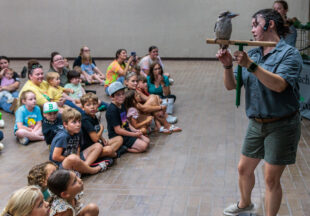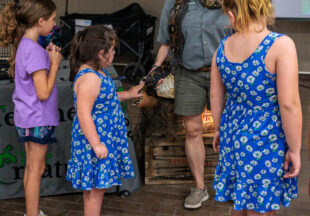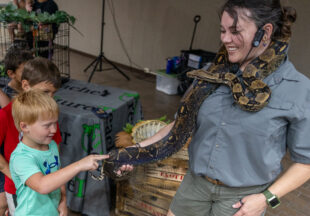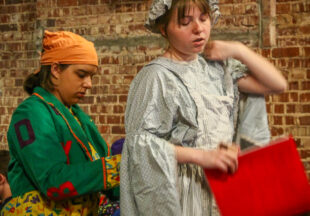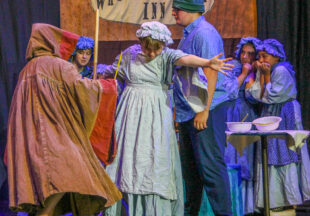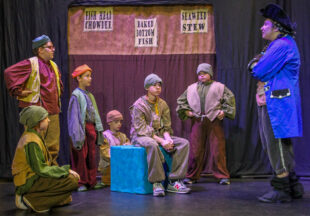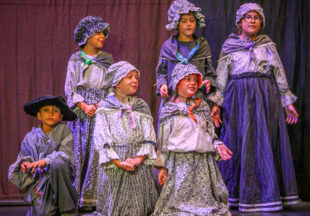Stephens County Chronicles: First railroad established Breckenridge as regional hub
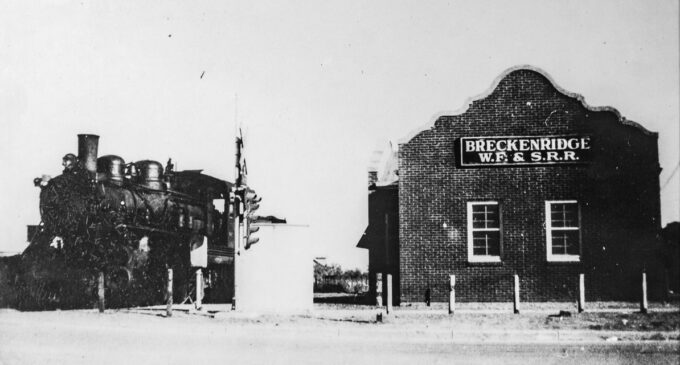
By Jean Hayworth/Breckenridge Texan
In June 1920, the scene was set for a multi-day celebration in Breckenridge. Along with a carnival, Clark’s Greatest Shows and Professor Cook’s Circus Side-Show and Museum, and a wrestling match with the top Texas heavy-weight, the first train was scheduled to arrive in town.
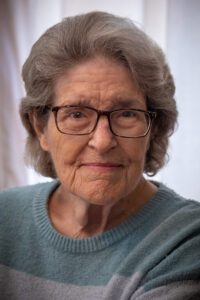
Jean Hayworth
On Sunday, June 30, 1920, the cinder-spitting, smoke-coughing train triumphantly steamed into Breckenridge at 8:30 a.m. to a huge crowd of Stephens County residents. The Wichita Falls, Ranger and Fort Worth railroad (W.F. R & Ft. Worth RR) arrived with four open coaches and passenger coaches. On board were the railroad dignitaries: the General Manager P. J. Neff, the General Freight and Passenger Agent J. M. Strupper and the Railroad Superintendent F. J. Hawn. In charge of the train’s entrance into town was Conductor Griffin, Engineer Homer, Fireman Dillard and Brakeman Miller.
Breckenridge Mayor Henry Walker Sayle and other community leaders met the train as the Breckenridge City Band played to the large, eager crowd of well-wishers. A second train arrived at 6:05 p.m. with Conductor Lee, Engineer Cantwell, Fireman Davis and Brakeman Jones. In the intervening hours, there was a tour conducted through the newly constructed railroad yard and depot that had been prepared for the W.F., R. & Ft. Worth train in the southeastern part of the city, on the east side of Gunsolus Creek.
The first train to leave Breckenridge that day was at 6:30 p.m., with four passenger coaches and a baggage car, along with the railroad dignitaries and guests. The departure for Ranger originally was to include only two coaches and a baggage car. However, there was such a crowd demanding a ride on the new mode of transportation that the superintendent relented and allowed two more coaches to be added.
In Breckenridge, there still were railroad yards to complete and warehouses under construction on the east side of the creek. Also, there were more tracks to lay that would eventually accommodate 100 cars. Another 500 rail cars would subsequently be handled in northeast Breckenridge, off of Front Street. Additionally, there were 15 to 20 industries that wanted spur tracks laid to their warehouses. Within the next few days, there were two switch engines due in and a turntable due by the end of the week.
The rail connections, along with the oil boom, established Breckenridge as a hub in the region.
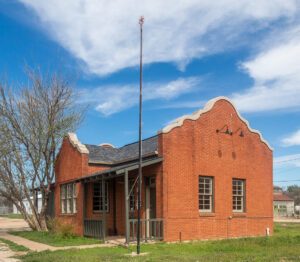
The original W.F. Ranger and Ft. Worth Railroad depot still stands in Breckenridge today. Currently, Ridge Nutrition is located in the building pm East Walker Street, selling shakes, teas and other items. (Photo by Tony Pilkington/Breckenridge Texan)
According to Neff, express freight services would begin promptly on July 1, 1920. The fee to travel from Breckenridge to Ranger was set at 92 cents.
Breckenridge immediately recognized a serious problem when large crowds came on every train into town, as many as 1,200 daily. There was no adequate housing or hotels available for the incoming crowds. Every hotel – there were three – was full and overflowing. Likewise, every rooming house and the private homes with a room were full. Some of the workers slept in eight-hour shifts.
Tent quarters were erected all over town while two more hotels were under construction: the Sager with 100 rooms and the two-story Pearson Hotel. They were added to the Colonial, California and Majestic Hotels already in operation.
The first load of oil field tools arrived first thing Monday morning from Jakehamon (in northeastern Comanche County) for the Ranger Caldwell Oil and Gas Co. The tools were needed to commence drilling three oil wells on the E.C. Ward tract located just north of the public school.
The population of Stephens County in 1919 was about 700 people. By June 1920, the population had swelled to 8,000, and it was projected to rise to more than 20,000 by the following year. Oil field operators and the leading businessmen predicted the substantial increase in population and believed that Breckenridge would be another Tulsa.
The W.F. R. & Ft. Worth RR established through train service from Breckenridge to Dublin by June 27, 1920. Train No. 4 was set to leave Breckenridge at 6:10 a.m., with stops at Breckwalker (southeast of Breckenridge), Frankell (east of Wayland), Ranger, Edhobby (southeast of Ranger), Jakehamon, Neff (in western Erath County) and to Dublin. Train No. 8 left Breckenridge at 8:30 p.m. and followed the same schedule of stops. Daily freight service was available between the above listed towns. An evening train departed Breckenridge at 6:05 p.m., and a morning train left at 6:05 a.m.
A concrete and steel bridge was built on Dyer Street, across the Gunsolus Creek, to allow entrance into the north rail yard. The bridge was 15 feet wide and 70 feet long. It would make a direct route into the northeast rail yard for the W.F.R. & Ft. Worth RR. The sturdy bridge also allowed trucks or cars to enter the rail yard and not have to go around to Walker Street.
The bridge over the Gunsolus Creek on Walker Street was a huge problem since the traffic over the bridge had increased tremendously and the bridge was not adequate to accommodate the increased load. A new 80-foot bridge was needed, but the County Commissioners continued to authorize repairs only. Meanwhile, railroad personnel ended up directing traffic around the Walker Street obstacles when repairs were being done. The two other bridges over the Gunsolus could be used instead. One bridge was the new bridge on Dyer Street, just two blocks north, and the other was two blocks south of Walker Street.
As the railroad continued to deliver services to Breckenridge, adjustments were made. Train No. 8 would make a connection to the Frisco RR at Dublin for Brownwood and points south. It also made connections to the Missouri, Kansas and Texas RR (M.K. & T), to Gorman and Deleon and points east. The Jakehamon and Kell RR trunk lines would connect Breckenridge, going north, to Wichita Falls and Oklahoma and south to Cisco, Eastland and on to south Texas.
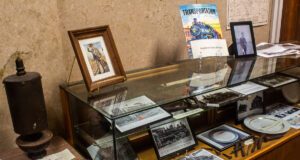
A display at the Swenson Memorial Museum features photos and other items related to Breckenridge’s railroad history. The museum currently has a special railroad exhibit on display near the front entrance. (Photo by Tony Pilkington/Breckenridge Texan)
The rail connection to Eastland became more desirable to handle the increased freight to Breckenridge, and Eastland, would also allow connection to the Texas & Pacific RR that went east and west. The additional line to Eastland would increase the number of freight cars to haul more oil out of Breckenridge and bring required tools, equipment, lumber and other needed supplies to town more quickly.
The Eastland & Ringling RR was set to enter Breckenridge by Sept. 1, 1920. The tracks for the Ringling Trunk line were soon at Wayland and would soon have track laid directly into Breckenridge. The Jakehamon Trunk line had already come to Breckenridge on tracks of the W.F. R. & Ft. Worth rail line. It went by way of Dublin and Ranger, with a depot and rail yard at Ranger. The contract had already been set for the immediate extension of the Ringling-Eastland & Gulf RR from its present terminus at Wayland to a point on the Hamon-Kell RR, between Breckwalker and Necessity, a distance of three and a half miles. Construction was to begin immediately to be completed within 30 days.
The Eastland connection meant more trains per day for both passengers and freight. Also, there would be a new connection with the Katy RR at Magnum, south of Eastland, by the new route and at Eastland, with the connection to the T & P RR. Additionally, the Cisco & Northeast RR was also due to connect with the Ranger rail line extending to Newcastle, by way of Breckenridge, by Sept. 1, 1920. That meant there would be three rail lines into Breckenridge, including the original W.F.R. & Ft. Worth RR. Breckenridge was soon to be recognized as a real railroad hub, where a person could catch a connection in any direction. Freight also could be sent from any direction and arrive at Breckenridge from any direction.
The main problem was to get more hotels and rooming houses constructed to accommodate the increasing population. Additionally, the railroads had to get more tracks laid in the south and north rail yards and hub tracks to the various supply houses.
The Ringling RR had already delivered a new baggage car and several passenger coaches to Breckenridge, to be put into immediate use. The Cisco & NE RR would build their Depot at the corner of East Elm St. and N. Veale Ave.
Unfortunately, in mid August of 1920, there was unusually heavy, rainy weather that delayed work on the grading and laying of track for the railroad. By mid-August, the W.F.R. & Ft. Worth RR was busy building more rail yards to accommodate more freight deliveries and more tracks were required to allow greater capacity to load and unload freight.
Additionally, many oil supply businesses were building more warehouses in the rail yard on the east and west side of the Gunsolus Creek. Another hotel, the Miller Hotel, with 70 rooms, opened by the proprietor, J. S. Hood. The Sager Hotel would soon be completed, as well as the Pearson and Stephens Hotels.
The Post Office was on its third move to larger quarters to accommodate the growing population. They installed 750 call boxes and had two windows to handle mail to individuals. Mail delivery was not an option because houses and businesses had not been numbered. As a result, all mail business had to be conducted at the Post Office. When the W.F.R & Ft. Worth RR was expanded to Newcastle, a regular mail coach would be used on through runs to Wichita Falls, with the required postal clerks to sort the mail.
Three new engines were enroute to Breckenridge, which would haul more freight cars per each train, which was largely oil field supplies and lumber to build more oil derricks. Passenger service on the Cisco & NE RR would be extended to stops at Leeray (north of Cisco) and Parks. Since the Eastland RR was planning to be in Breckenridge by Sept. 1, 1920, a large Labor Day celebration was tied to its arrival, for Sept. 4. There would be a parade of oil field workers and a variety of Union representatives were to come from Desdemona to participate in the Labor Day celebration.
City leaders encouraged citizens of Breckenridge to take a Sunday walk or drive and see all the new changes to the landscape of the city. A new housing development was going in near the new school in the northeastern part of town. There were all kinds of changes in the expanding rail yards, both in the southeast and northeastern parts of the ever expanding rail yard. Additionally, Western Union and Southwestern Bell Telephone was putting new lines into Breckenridge, and the city was exploring the idea of getting a radio station, with the new direct lines to Fort Worth.
On the horizon, was a fourth railroad line that would come directly into Breckenridge from Mineral Wells, the Texas & Pacific RR. It was true that the Eastland RR made a connection to the T & P RR, but this would be a direct line that could have a night train to Fort Worth or Dallas. It was due to arrive by mid-October.
The W.F. R. & Ft. Worth RR was limited only by the equipment and cars available for their use to get into Breckenridge. The T & P RR, Cisco & NE RR and the Eastland RR, with the Ringling Trunk line included in the Interstate system, would pull all the Pullman and freight cars required to handle all the volume into and out of Breckenridge.
The Breckenridge oil industry would benefit from all the increased rail service available. There were all kinds of employment opportunities in all phases of the rail operation in the depots, tracks, supply houses and warehouses. Employees laid off in other areas that were declining in oil production could easily find a job in Breckenridge.
There also was serious talk of a refinery for Breckenridge due to the increased volume of production. At that time, oil was piped to Graham, Ranger or Eastland refineries. Ground was broken for a new hotel, the Majesty, next to the Methodist Church. It would be of more substantial construction with concrete and steel, with a brick exterior. The hotel was to have 100 rooms and the owner, C.M. Oliver, stated that it would be fireproof.
By August 25, the news came in that the proposed Cisco & NE RR would come into Breckenridge on their own tracks and was expected by mid-September. They were busy building tracks to their own Depot and rail yard to handle passengers and freight. Meanwhile, oil production had increased in the northern part of Stephens County, at Ivan, South Bend and Eliasville, on the Young County line. Based on that information, additional storage tanks, loading racks and more pipe lines were under immediate construction. A 200,000 barrel capacity was projected for Breckenridge.
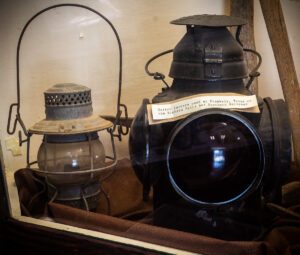
This switch lantern, right, was used at Frankell in southeastern Stephens County, by the Wichita Falls and Southern Railroad. The lanterns are a part of the railroad exhibit at the Swenson Memorial Museum. (Photo by Tony Pilkington/Breckenridge Texan)
Ranger was laying more pipe to their refinery to handle the increased oil production from Breckenridge. Cisco was also laying pipe into Breckenridge from their refinery for the increased oil production. Stephens County reported a record 81,246 barrels per day that surpassed their record of 75,000 barrels that had beat the record set by Burkburnett previously. The possibility of Breckenridge hitting 100,000 barrels per day was a real possibility.
The Eastland RR arrived in Breckenridge by Sept. 1, 1920, with much fanfare. It brought in much freight for Breckenridge, and additional cars of freight were also arriving from Breckwalker. The Cisco & NE RR was completing their grading in the city to its Depot and rail yard. It had required heavy blasting for a few days to complete laying their railroad tracks into Breckenridge and expected to be rolling into town by the middle of September.
There was a plea sent out to all business enterprises that were expecting freight to come in person to the rail yard and claim their freight. Notices had been sent out, but some might have missed the correct business. There was a backlog of unclaimed freight. Managers could refuse further freight shipments for a business or person until the present shipment was claimed and removed from the rail yard.
A new town site was being organized four miles north of Breckenridge and one mile east. It included town sites and business sites, a hotel and oil supply businesses. The new town was named Jimkurn, named for James M. Kurn of the Frisco RR. Jimkurn would open on Oct. 4, 1920, with deep, clear water for fishing and swimming. It was projected to be a distribution center for the vast oil interests of Stephens County. The town site was on the W.F. R. & Ft. Worth RR line and connected to the Frisco RR. The connection advertised Pullman cars into Fort Worth every night on the 10:45 p.m. train.
The Cisco & NE RR arrived ahead of their projected schedule, on Sept. 8, 1920. On its maiden voyage, it carried businessmen from Cisco, Leeray, and Parks into Breckenridge. Once again, the Breckenridge Band played and Mayor Sayle and Breckenridge community leaders met the train. As advertised, the Cisco & NE RR offered direct connection to the T & P RR, on the Sunshine Special to travel east to Fort Worth and Dallas or west to Waco. They were constructing a $20,000 Depot and the necessary rail tracks in the Breckenridge rail yard.
There also was the Grand Opening of the Sager Hotel, which advertised running water and showers in each room and which was advertised as a fireproof structure.
The increased oil production in the northern part of Stephens County presented an immediate problem. Graham had made a serious overture to transport their oil to their refinery and put up $300,000 to entice the oil producers to go with their route.
Breckenridge community leaders heard of the attempt by Graham and took immediate action. Breckenridge immediately raised $300,000 that day and added another $200,000 overnight to counter the Graham power play. Additionally, William Black went to Wichita Falls to confer with Frank Kell, president of the W.F. R. & Ft. Worth RR. The next day, Mr. Kell announced that the Kell RR, which went on to Newcastle, would come directly to Breckenridge and bypass Graham. That made another railroad into Breckenridge. Breckenridge would use $100,000 of the money raised to help Mr. Kell construct tracks into Eliasville for the Rock Island RR. Additionally, Breckenridge would use part of the money raised to improve the highway to the northern parts of the county and to their oil well locations.
Breckenridge had also contracted for new telegraph and telephone lines into Breckenridge and would connect to the northern parts of the county, which would include Ivan, South Bend and Eliasville, on the Young County line. Thus, Breckenridge had out-maneuvered Graham on their attempted power play, and Stephens County oil would remain in Stephens County.
The Cisco, Rock Island and Pacific RR ran from Breckenridge by 1921. It met the rail lines of the W.F. and Pacific RR south of Jimkurn and ran to Eliasville and then north to Wichita Falls and Newcastle. It ran out of Breckenridge as late as 1969, according to older Breckenridge residents. The Rock Island RR folded in 1975.
To learn more about the history of railroads in Stephens County, visit the Swenson Memorial Museum at 116 W. Walker in downtown Breckenridge. The museum is open from 10 a.m. to 5 p.m. Thursdays and Fridays and from 10 a.m. to 2 p.m. on Saturdays.
Cutline, top photo: The railroad depot on East Walker Street in Breckenridge was initially built by the W.F. Ranger and Ft. Worth RR, the first railroad in Breckenridge. The first trains steamed into Breckenridge on June 30, 1920.
Jean Hayworth is a columnist for the Breckenridge Texan, writing about the history of Breckenridge and Stephens County. Originally from Pennsylvania, she’s lived in Breckenridge since 1975. Hayworth is a veteran of the U.S. Navy, as well as a former school teacher and newspaper reporter/editor/columnist. She also works part-time for the Swenson Memorial Museum in Breckenridge. Click here to read more about her and the beginnings of this column.
Make sure you don’t miss any of the Breckenridge Texan’s news…click here to sign up for our email newsletter, the Weekly News Roundup. It has links to stories, photo galleries and more! It’s free to sign up, and it comes to you on Monday mornings (Tuesdays, after a holiday).











